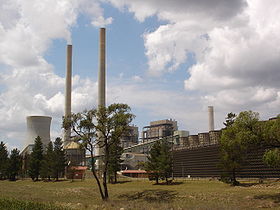
Wallerawang Power Station, New South Wales
Encyclopedia
Wallerawang Power Station is located near Wallerawang
, in the Central West of New South Wales
, Australia
. It is coal
powered with two steam turbines and two 500 MW GEC (UK) alternators with a combined generating
capacity of 1,000 MW.
 Wallerawang was originally built with four 30 MW generators, completed in 1957-1959, which were referred to as Wallerawang A. Wallerawang B consisted of two 60 MW generators completed in 1961. Wallerawang A and B have both been decommissioned. The two 500 MW units in the current Wallerawang C station were completed in 1976 and 1980.
Wallerawang was originally built with four 30 MW generators, completed in 1957-1959, which were referred to as Wallerawang A. Wallerawang B consisted of two 60 MW generators completed in 1961. Wallerawang A and B have both been decommissioned. The two 500 MW units in the current Wallerawang C station were completed in 1976 and 1980.
Wallerawang draws its cooling water from Lake Wallace and Lake Lyell, fresh water lakes on the Coxs River.
The coal for Wallerawang comes from mines in the local area, delivered by private road. 75% of the coal comes from the Angus Place colliery.
Carbon Monitoring for Action
estimates this power station emits 7.00 million tonnes of greenhouse gases each year as a result of burning coal
. The Australian Government has announced the introduction of a Carbon Pollution Reduction Scheme
commencing in 2010 to help combat climate change
. It is expected to impact on emissions from power stations. The National Pollutant Inventory provides details of other pollutant emissions, but, as at 23 November 2008, not CO2
.
Wallerawang, New South Wales
Wallerawang is a small township in the Central West of New South Wales, Australia. It is located approximately 14 km northwest of Lithgow on the Main Western railway line at the junction of the Gwabegar line. A now closed railway station opened in 1870. Wallerawang Power Station opened in...
, in the Central West of New South Wales
New South Wales
New South Wales is a state of :Australia, located in the east of the country. It is bordered by Queensland, Victoria and South Australia to the north, south and west respectively. To the east, the state is bordered by the Tasman Sea, which forms part of the Pacific Ocean. New South Wales...
, Australia
Australia
Australia , officially the Commonwealth of Australia, is a country in the Southern Hemisphere comprising the mainland of the Australian continent, the island of Tasmania, and numerous smaller islands in the Indian and Pacific Oceans. It is the world's sixth-largest country by total area...
. It is coal
Coal
Coal is a combustible black or brownish-black sedimentary rock usually occurring in rock strata in layers or veins called coal beds or coal seams. The harder forms, such as anthracite coal, can be regarded as metamorphic rock because of later exposure to elevated temperature and pressure...
powered with two steam turbines and two 500 MW GEC (UK) alternators with a combined generating
Electricity generation
Electricity generation is the process of generating electric energy from other forms of energy.The fundamental principles of electricity generation were discovered during the 1820s and early 1830s by the British scientist Michael Faraday...
capacity of 1,000 MW.

Wallerawang draws its cooling water from Lake Wallace and Lake Lyell, fresh water lakes on the Coxs River.
The coal for Wallerawang comes from mines in the local area, delivered by private road. 75% of the coal comes from the Angus Place colliery.
Carbon Monitoring for Action
Carbon Monitoring for Action
Carbon Monitoring For Action is a website that contains a searchable database that estimates the carbon emissions of power plants and power companies around the world. Launched in November, 2007, its database is updated quarterly. It is produced and financed by the Center for Global Development....
estimates this power station emits 7.00 million tonnes of greenhouse gases each year as a result of burning coal
Coal
Coal is a combustible black or brownish-black sedimentary rock usually occurring in rock strata in layers or veins called coal beds or coal seams. The harder forms, such as anthracite coal, can be regarded as metamorphic rock because of later exposure to elevated temperature and pressure...
. The Australian Government has announced the introduction of a Carbon Pollution Reduction Scheme
Carbon Pollution Reduction Scheme
The Carbon Pollution Reduction Scheme was a proposed cap-and-trade system of emissions trading for anthropogenic greenhouse gases, due to be introduced in Australia in 2010 by the Rudd government, as part of its climate change policy. It marked a major change in the energy policy of Australia...
commencing in 2010 to help combat climate change
Climate change
Climate change is a significant and lasting change in the statistical distribution of weather patterns over periods ranging from decades to millions of years. It may be a change in average weather conditions or the distribution of events around that average...
. It is expected to impact on emissions from power stations. The National Pollutant Inventory provides details of other pollutant emissions, but, as at 23 November 2008, not CO2
Carbon dioxide
Carbon dioxide is a naturally occurring chemical compound composed of two oxygen atoms covalently bonded to a single carbon atom...
.
External links
- Delta ElectricityDelta ElectricityDelta Electricity is an electricity generation company in Australia. It is fully owned by the Government of New South Wales, and has a portfolio of generating sites mainly using thermal coal power.-Power stations:...
page on Wallerawang

